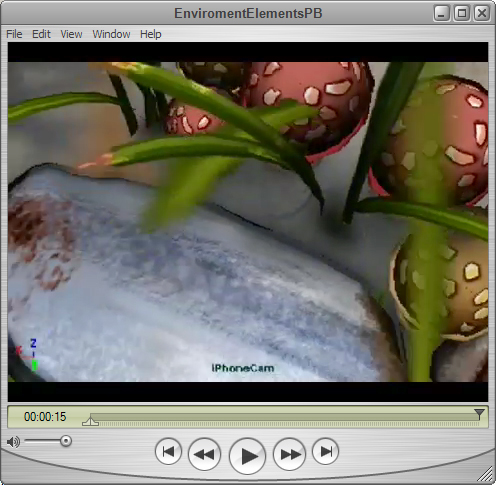
the really fun thing about creating a game on the iPhone/iPod Touch is it takes you back to the garage days of creating games. stripping out the "fluff" and sticking with what is strongest visually, simplest to learn, and most fun to play.
when we decided that squish squash would be our first game, we broke one of our own rules about "keeping it simple"...we decided to do a game about bugs. "what's the big deal?" you may ask. well, we're talking about nature. when you talk about nature, you have to make your environments feel organic and alive. environments in games have always been a big cookie to crumble...but outdoor environments are especially challenging.
however, for our first game developed completely in-house...we knew that a game that marries core play elements from games like space invaders and fantavision and wraps it around the concept of squashing bugs was something that would be super fun for parents and kids alike. so creating organic environments was a hurdle we knew we couldn't avoid. not only could we not avoid it...we had to conquer it in a way that sticks with our mantra of making everything that comes out of our studio top notch.
big question is how do you create something interesting and unique looking while keeping the art assets efficient enough so the game can run smoothly.
i've already blogged about how we're using time of day to add that element of emmersion and variety. while a very handy and gorgeous tool to use when getting mileage out of the art we create, that's only one piece of the puzzle. the other is to keep the number of unique assets to a minimum and reusing them in unique configurations. however, lots of times that equals the artists losing control over the minute details and variation that gets applied.
in the past while working at studios like Naughty Dog, EA, and Microsoft...the answer was very powerful, yet complex tools and game engine architecture. things we simply didn't have the time and budget to fit into our production schedule. we had to come up with something that gave us the ability to pack a visual punch, yet be a process that's simple and straightforward.
we started thinking about those dioramas we all had to do in school. you remember those things, right? i remember mine, it was about the cretaceous period. i took a shoe box, cut it up to create a stage, i lined the walls of the box with foliage. i then created the ground by adding sand, created little clusters of trees, plants, and rocks, and finally i bought little dinosaur figurines to populate it.
we decided to apply that same exact approach to our environments for squish squash.
we're treating the area where the bug's roam as the shoe box/stage. we're surrounding the playing field with 3d foliage and we've created a nice sandy texture for our ground.
the image above is our ground texture element. this is applied much like the ground element in a diorama
so, we've got our "shoe box stage" set up. now comes the hard part...adding environmental elements that breaks up the ground plane and give art directed variety while not slowing down the game. just as with the old school dioramas, we chose to create a library with clusters of environmental elements. much like those little decorative doo dads folks buy to put in their fish tanks. see, most of the time the solution becomes something where the artist creates individual pieces and that gets placed randomly by the game. most times this ends up giving the environment a lack of cohesion or artistic interest because there is much less creative control. our approach allows the artist to hand create complete little sets of artwork that THEN get placed in the game engine. efficient, yet more controlled on an artistic level.
during pre-production, we did all sorts of concept artwork for various elements one would find in a forest.
the image above is a collage of some of the select concepts for enviromental elements. there were several elements we kicked around, ultimately settling on mushrooms, rocks, and blades of grass. these were the elements that worked best game design-wise and also efficiency-wise
next we took these concepts and created 3d versions of them in Maya. once all these individual elements were created, the task was to assemble them into unique and art directed clusters.
next we took these concepts and created 3d versions of them in Maya. once all these individual elements were created, the task was to assemble them into unique and art directed clusters.
the series of images above show how the concepts were interpreted in 3d within Maya to first create individual mushrooms. then we would take the individual mushrooms and create a specific cluster of mushrooms. those clusters are then placed in various configurations in the game. all of these clusters applied in various combination's on the iPhone gives a nice sense of lushness while not sacrificing the performance of the game.
here real soon, you'll be able to experience for yourself how all this stuff adds to our game. in the meantime, click on the "WIP" image below to see a mocked version of the camera looking over an assembled enviroment.
here real soon, you'll be able to experience for yourself how all this stuff adds to our game. in the meantime, click on the "WIP" image below to see a mocked version of the camera looking over an assembled enviroment.





No comments:
Post a Comment